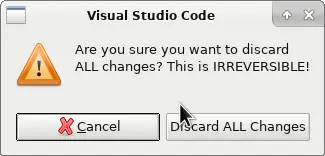Typical web developer. He didn’t even know files can be deleted without going into „recycle bin”
Why are we dissing web developers? What is this bullshit elitism?
I think it’s a joke about how noobs only learn javascript and make blazing fast webapps while knowing nothing about computers.
Say you don’t know how to use git without saying you don’t know how to use git.
That’s what happens when people stumble across that website called GitHub, get hooked and now have unrealistic expectations for the real git.
“I just installed Git for Windows. Where is the drag-to-upload box?”
— A statement dreamt up by the utterly deranged
Real git involves a lot of sweat, requires you to clean up any mess you make, and communicate with any partners about their preferred techniques instead of rawdogging it and waiting for issues. The pushing and pulling will come naturally but you need to know how and when to release, and be clear about how you wish to commit. People might judge you for using the word “master” but it should be alright in private.
I’m literally a software dev working for a top company and I can barely use git on the CLI. I do all of my version control operations using a GUI, so there’s no sense in gatekeeping any of that. This is true of both my work projects and personal ones. It’s cool if you prefer the CLI, but it is absolutely not a required skill in order to have a successful and meaningful career.
I agree that the gatekeeping isn’t a good thing, but you should learn at least the basics of the CLI. It will give you a better understanding of what’s going on behind your GUI and makes troubleshooting and fixing problems a lot easier.
Definitely not required but it is absolutely a skill worth having.
It’s absolutely not a skill worth having. If you ever run into issues and need the CLI, you can always get your knowledge right in that moment. If you already can do everything with your GUI and get the same results, getting the knowledge to do it some other way is just wasted time and duplicate work.
involves a lot of sweat, requires you to clean up any mess you make, and communicate with any partners about their preferred techniques instead of rawdogging it and waiting for issues. The pushing and pulling will come naturally but you need to know how and when to release, and be clear about how you wish to commit. People might judge you for using the word “master” but it should be alright in private.
Don’t talk about my mom that way
People might judge you for using the word “master” but it should be alright in private.
I snorted. It was my inner 12-year-old’s fault. (Also because of recently some idiots getting up in arms about these terms in technology.)
“up in arms”:
Reality:
– “just don’t use them, some people find them offensive”
– “ok”Anonymous techbros online:
“yOu CanT sAY aNYtHiNg ThEsE daYs”
Git doesn’t automatically recursively add all files in the directory to the repository though - VSCode decided that should be the default behavior, while other editors (intellij) ask if you want to add newly created files to version control
That’s how git works. Every file and subfolder under the repo’s root folder belongs to the repo.
Alright you convinced me its time to pick up this skill. How does one best learn git? Just play around with it and break things?
read the official book : https://git-scm.com/book/en/v2
That’s basically how I did it.
To properly learn it using this method, create a directory that contains only text files and sub directories and treat it like a real project. Add files, delete them, play around with updating the repository. Try and go back a few updates and see how the things react. Since it’s not a real project there’s no risk of loss, but you’ll still get to see the effects of what you do.
that’s a necessary step in your learning process, but certainly not sufficient. I’d recommend reading the book, since it shows in greut detail the inner workings of Git along with the basic concepts :
is op stupid ?
let’s turn this into a constructive angle for future devs and current juniors: just learn git cli, I promise you it is much simpler than it seems.
all those memes about git having like a thousand commands are true, but you really will only use like 7 at most per month.
learn push, pull, merge, squash, stash, reset, im probably missing like one or two
I promise you again: it is much simpler than it seems. and you won’t have to use these stupid git GUI things, and it will save you a hassle because you will know what commands you are running and what they do
short disclaimer: using git GUI is totally fine but low-key you are missing out on so much
Every time I mentor a dev on using git they insist so much on using some GUI. Even ones who are “proficient” take way longer to do any action than I can with cli. I had one dev who came from SVN land try and convince me that TortoiseGit was the only way to go
I died a little that day, and I never won her over to command line despite her coming to me kinda regularly to un-fuck her repository (still one of the best engineers I ever worked with and I honestly miss her… Just not her source control antics)
If I want to commit a selection of files, but not others, then I’m clicking boxes not typing filenames.
git add -p
So I’m normally a command line fan and have used git there. But I’m also using sublimerge and honestly I find it fantastic for untangling a bunch of changes that need to be in several commits; being able to quickly scroll through all the changed files, expand & collapse the diffs, select files, hunks, and lines directly in the gui for staging, etc. I can’t see that being any faster / easier on the command line.
The difference in speed is familiarity, not some inherent efficiency gain by typing commands into the cli.
Checkout
The main draw to the CLI for me is portability. I’ve been a dev for ten years now and used tons of different editors on different platforms and while each one had a different way to describe the changes, how to commit, or how to “sync” (shudder), the CLI hasn’t changed. I didn’t have to relearn a vital part of my workflow just because I wanted to try a different editor.
How about Git’s CLI stop being so shit? All of the options are obtuse & usually 3 ways to do the same thing.
Developers should normalize non-Git DVCSs.
Personally, I’m pretty good with the CLI version, but sometimes I just use the Code VC interface. For some tasks (basic commit, pull, push) it’s pretty fast. I don’t know if it’s faster than CLI, but I switch between them depending on what I’m doing at that moment. Code has a built in console, so using either is pretty seemless and easy. If you only use the GUI you won’t ever understand it though. I think everyone should start with CLI.
Honestly, this is true for almost everything. GUIs obfiscate. They don’t help you learn, but try to take control away so you can’t mess up, and as an effect can’t do everything you may want.
For a first step you can get away with just add, commit, push, and pull. Maybe reset, but tbh using git like svn at first is fine.
Next branch, checkout and merge. At this point show, log, bisect and blame also start to be useful.
I’m not a fan of stash, and would instead recommend reflog and cherry-pick as the first two advanced commands to learn. Then rebase and squash.
Clone too 😁
im probably missing like one or two
commit. Lol
You get pretty far with just clone, pull, add, commit, push
I use gitkraken for two primary purposes:
-
Having a visual representation of my project history.
-
resolving merge conflicts
Of these, the first is really the only thing I really want a GUI for. I’ll just have it open on my side-screen if I’m managing some more or less messy branch structure or quickly want an overview of what has been done on which branches, where common ancestors are, etc. All the actual doing of things is done from the CLI, because it’s just better for that.
-
The real issue is already going 3 months without source control.
I have heard things from another apprentice who just does not use version control at all and the only copies are on his laptop and on his desktop. He is also using node.js with only 1 class and doesn’t know about OOP (not sure if you even use that in js no clue 😅) and has one big file with 20k lines of code I have absolutely no clue how he navigates through it
He just heard monoliths were in again
Those are rookie numbers. I have at least a 35k one somewhere. More than one actually.
People run their businesses on this.
I once landed a job at a small company doing a software for medical analysis labs all over the country. Software had been around for over ten years at this point. They had no source control. Nothing. Absolute nightmare.
They were literally starting to use source control when I arrived.
In 2015.The “source control” when I first started was all the code on a shared drive, to check out a file you copied it to your machine, and renamed the extension on the shared drive to your initials.
When somebody edited without doing this there would be full blown meltdowns over lost work.
Ey! Reminds me of my middle-school years! I still can’t belive I made an entire game without a single class… Just storing info in arrays and writing in comments what location represents what data. But I was a literal child, too young to read guides or sit through “long” tutorials.
I don’t want to sound too mean, but whenever I see anything similar at work, I wish that person get a job they’re actually good at. It’s fine and all that the company started hiring actual programmers to fix things, but the fact that the old crew still fucks shit up with senior privileges is a major grievance.
I know the type. Usually the kind of confident know-it-all who refuses to learn anything but delivers changes really quickly so management loves them. I had the misfortune to fix such a project after that ‘rock-star’ programmer left the company. Unfortunately the lack of professional standards in our industry allows people like that to continuously fail upwards. When I left the project they rehired them and let them design the v2 of the project we just fixed.
When I left the project they rehired them and let them design the v2 of the project we just fixed.
Lol. Wow.
And that is why I’ve been unable to work myself out of a job in all my long years as a developer.
Jesus, reminds me of a similar story. My gf once lost a job to someone who literally just pasted code into LLMs, also delivering quickly, even tho it was hot garbage. Anyhow, she spent a lot of her time fixing his shit and so her output went down. I hope that company burns to the ground with completely un manageable software.
My company for the longest time had two engineers they would give all the new projects to. They would rush through some prototype code as fast as they could then management would bring in a new team to take the project over. The code was always garbage and crammed into one place. I kept getting new projects and instead of starting from a nice clean slate we always had to build on that garbage. It sucked so bad.
We really need some kind of board like the one that controls the title for engineers.
Reading this just give me a panic attack
The person didn’t have any git repository; probably a new programmer that didn’t know how version control works and just clicked discard without understanding what that means in this situation
Often times, people learn that the stove is hot by touching it.
It’s easier to blame the stove than the person who touched it. But if you laugh when you watch it happen, you’re probably not laughing at the stove.
I fucking HATE when abstractions over git use cutesy names that git doesn’t use.
Honestly no idea why someone would go around a completely unknown menu in a new unknown editor and randomly click things with caution completely out the window. Not having a copy or trying a blank project, not even reading any messages. I mean even if we don’t know it’s a nuke button, God knows what other edits it could do to your code without you knowing.
This goes beyond rookie mistake. This is something 12 year old me would do. Same with the issue page being 90% swear words.
I don’t even know why people ITT are blaming the IDE and completely ignoring this.
When you learn git, you do so on a dummy project, that has 5 files which are 10 characters long each.
An IDE is not made so you can’t break things, it is tool, and it should let you do things. It’s like complaining that Linux will let you delete your desktop environment. Some people actually want to delete your desktop environment. You can’t remove that option just because someone can accidentally do it by ignoring all the warnings.
Linus Sebastian enters the chat
They could have a warning though. I agree with you, but there are some easy ways to prevent this from happening. It just takes time to implement, and would be required in other places too. Is it worth the dev time? I doubt it.
There is a warning. IIRC it says “are you sure you want to discard all changes? This action is unreverisble”. In the context of version management. Creating a file is a change. And just below the button to discard all changes is the list of changes. In that list he could’ve seen 3000 changes of the type “file creation”, when you discard a file creation, it means to undo the creation, which is a deletion.
The button days what is going to do. There is a warning about what it’s going to do. And there is a list of the exact changes it’s going to undo.
The only way to avoid this from happening is to not have the button exist. In that case, the users that actually want to discard all changes would be unable to do so.
Got will not delete untracked files though, which is what happened here. If you want to discard changes to a file with git, you first have to commit the file to the index at some point, which means there’s only ever so much damage an erroneous “git restore” or “git reset” can do. Specifically, neither of them will delete all the files in an existing project where VC has just been added.
Mein Gott!
This user was not using git though, he was using vs code. That button doesn’t say “git reset” it says “discard all changes”. And btw, what it does is “git clean”, which is something that git can do.
Just below the button there is a list of all the changes. In his case, there were 3000 changes of the type “file creation”. Discarding a file creation can only be made one way: deleting the file.
Anyway, this user is presumably in his learning phase, I would not assume that he knows what git reset or git restore actually do.
Honestly no idea why editors give shit random names instead of using the terms git uses.
This is a disease of GUIs. Most people are so used to having their hands held and being unable to make a mistake that when a GUI actually gives you the power to fuck up they don’t expect it. I promise you, if this user was using the CLI, this wouldn’t have happened as easily.
I promise you, if this user
was using the CLIbacked up their files, this wouldn’t have happenedas easily.
Poor guy basically did a git reset —hard HEAD without even a git repository
Even reset hard wouldn’t delete untracked files. This was a complete overreach by the GUI, performing a
clean(and likely a forced one, as git’s requireForce defaults to true).And they did rectify that eventually, giving a warning, and an option to simply reset. It’s unfortunate this poor person had to be the trigger for that change.
Skill issue
I don’t know anything about programming, i came here from /all, but it seems to me that a command that’s this permanently destructive warrants a second confirmation dialog message reminding the user that the files will be permanently deleted and not undoable
I think it’s important to know that this program is for code developers, and the issue here is with a tool called git. Git is like file saving on steroids, because on top of saving a single file, you save many changes to files in git, add a comment for why you made those changes, and share your changes across dozens of files with other developers.
What this guy did was develop for many months after starting to use git, but he never actually committed the files. Then he asked for to reset everything back to the original state, something that I do multiple times a day, and it gave him a warning that original means original and you will lose everything. And he said do it anyways.
No he asked for a discard after importing the project into VS Code. discard in git terms refers to
git reset, notgit clean. Even if he wanted to run agit resetthen this version of VS Code would have run agit cleanand deleted everything. Imagine he committed all 5000 files, but had a secret.json that he hadn’t committed. He didn’t add it to gitignore either. Running agit reset --hardwill not delete this file, but the VS Code button did exactly that because it ran agit clean.
Here is the exact warning that a user had to click through in order to get to where they got:

That’s not a very good dialog box. He didn’t make any changes, so discarding them doesn’t sound like a problem.
There should be a notice when you enable source control that this will permanently delete all existing files with a checkbox (checked by default) that says “Add existing files to source control.”
He wouldn’t have seen the “Discard Changes” button at all if source control wasn’t already setup (and detected by VSCode).
No program will delete files either when you initialize source control.
My sibling ran into this issue once. I’m not sure if it’s a setting or a default, but vscode would assume they were working in a blank repo until they made a commit.
Sounds like this person had the project (without source control) in another IDE, tried out VSCode, and it assumed that it was all ‘changes’. I don’t use VSCode, do I can’t say for certain, but I know my sibling lost ~4 hours of project set up for the same reason (though they immediately realized it was their fault).
Reading your comment and #32459, I realize that VSCode source control did have some major issues back then.
It looks like they have improved though, as the latest VSCode I use doesn’t auto-initialize repositories anymore.
Hm ok yeah, that seems quite scary sounding so that i would strongly hesitate before clicking on “discard ALL changes”. Still, I wonder if a second confirmation dialog with more information is warranted for a command that’s so destructive.
I wouldn’t assume “discard changes” means “delete files that existed before the editor did”.
Then you don’t understand git or source control in general. If you don’t commit your changes, then you discard any changes, you’re set back to the last commit. Discarding changes also includes any un-committed new files.
Which is exactly the situation the dude was in. As a newbie, it’s an easy mistake to make. Telling somebody who doesn’t know “well, would you look at that, you didn’t know!” is not just unhelpful, it’s useless and condescending.
discarding changes does not discard uncommitted new files. The VS Code button did a
git cleanwhich is completely unexpected. Git even refers to a git clean with completely different terminology.git reset -> “Resets the index and working tree. Any changes to tracked files in the working tree since are discarded.”
git clean -> “Cleans the working tree by recursively removing files that are not under version control, starting from the current directory.”. This command also requires you to specify a force option to actually do something, else it quits with an error.
Note that git clean never once refers to discarding anything, and git reset never refers to removing untracked files. VS Code was doing an idiotic thing. Running
git reset --hardANDgit clean. There is absolutely no reason to be runninggit cleanfrom an UI button ever. If you want to remove a file you can explicitly remove it.Imagine that the button said “Discard all changes” and then it ran
rm -rf --no-preserve-root /*. Would that make sense as a button? No. It definitely would not.or like “unmount d:” but instead it formats d:
It’s changes from the prior commit in the repository, which, if they had not committed anything prior, would have been an empty directory.
This is perhaps a good lesson in teaching version control as its own concept rather than “streamlining it” by bundling it with an editor.
You shouldn’t be taking ownership of files and then deleting them without communication a hell of a lot better than that.
I understand what happened. I’m saying that if you’re going to delete stuff that was there before the software was, your flow to adding a project should include suggesting a base level commit of everything that’s there already.
That’s definitely fair, creating a repository in a non-empty directory could definitely suggest auto-committing the current state if it doesn’t already. I don’t use VSCode so I wouldn’t know.
Although now that I think about it, that could have been the intention here but not automatic, if that’s why 5k+ files were staged without the user explicitly staging them. Extra tragic if that’s the case.
Ok then, the changes to the repository shouldve been discarded. Anything he uploaded shouldve been deleted from the server. Why were files on his local machine deleted?
What makes you think a server was involved here? It was a local repository, evidenced by the reporter’s bewilderment that files can be deleted without going to the Recycle Bin first. Which tells us that in addition to VCS, they were unfamiliar with Windows as well.
The repository in Git isn’t on the server, it’s on your local machine.
It’s not that. It means discard all changes made after the last change committed to this local repository.
In this case it seems like it also performed a
git cleanand deleted his untracked files too. Someone actually opened a an issue to try and prevent the behaviour in the future
I guess cancelling would go back to the “Then you want to commit all files?” dialog, which the user didn’t want to, he just wanted to cancel whatever the IDE was trying to start.
The problem is that these are “source control basics” that everyone needs to learn the hard way once it seems.
Waiting 3 months in between commits however is a really bad rookie mistake because you were worried about making a commit that wasn’t perfect.
the problem is that VS Code ran
git cleanif you clicked yes, which is completely idiotic behavior. No other git client, text editor, or IDE on the planet does that.Either way, waiting 3 months worth of work before a commit is the big mistake here.
I think they hadn’t ever used git before, and according to at least one person in the linked issue, vs code might have auto initialized the git repository for the user.
In fairness, ALL git terms feel backwards at first.
Imperfect commits never existed when you squash.
Squash ftw. Simpler clearer history.
Interesting. I wouldn’t know, because I code everything perfectly the first time.
Disclaimer: The above flagrant lie was brought to you by my also using rebase and squash to hide all of my mistakes.
Perhaps. Still I am not sure why someone who is not aware of this would be using VSC. If they are a student then what kind of project are they working on that they have so many files?
I’m sure 99% of the files were node modules. The npm bloat is real.
They clicked discard changes, confirmed it, and the computer did as instructed. This operation is normally not so destructive as it only discards uncommitted changes to realign the local directory with the remote server. Unfortunately for user, it sounds like they have never committed a change, so realignment meant reverting to an empty folder.
If you ever happen to have 5000 uncommitted files, you shouldn’t be asking yourself if you should commit more often. You should be asking yourself how many new repos you should be making.
This is without gitignore, so probably just installed one js dependency
The person didn’t have any git repository; probably a new programmer that didn’t know how version control works and just clicked discard without understanding what that means in this situation.
Just curious, git doesn’t touch untracked files though?
‘git reset’ won’t. ‘git clean’, on the other hand, most certainly does. Even then you have to --force it by default, to prevent an accidental clean.
This person is why we have that meme where devs would rather struggle for a week than spend a few hours reading the documentation.
I feel bad for this kid. That really is a bad warning dialog. Nowhere does it say it’s going to delete files. Anyone who thinks that’s good design needs a break.
Half the replies are basically “This should be obvious if your past five years of life experience is similar to mine, and if it isn’t then get fucked.” Just adding insult to injury.
If you’re going to use a git tool, you need to know how git works.
There are 0 excuses for not having months of work in a repo, none. I have no sympathy whatsoever. How the fuck do you spend so many months without backing up your project or stuffing it in a repo?
No sympathy. Dude is a shit developer and he learned an invaluable lesson.
My guess is that this is a teenager, and this is probably their first experience with git and version control in general. Just a hunch.
Anyway, it is reasonable to expect a mainstream GUI app from one of the largest companies in the world to be approachable for people who do not know all the inner workings of the command line tools that are used behind the scenes. And it is reasonable to expect any destructive action to have clear and bold warnings. “Changes will be discarded” is not clear. What changes? From the user’s perspective, the only changes were regarding version control, so “discarding” that should leave them where they started — with their files intact but not in version control.
Have mercy on the poor noobs. We were all there once.
Also, why not send them to the recycle bin? I never really thought about it before, but that does seem a reasonable UX improvement for this case
I wonder if there’s already a git extension to automatically stash the working tree on every clean/reset/checkout operation…
Because “the underlying Git nukes them right away, so why shouldn’t we perma-delete the files, too?”
Anything else’d be effort…
Honestly it probably just runs the underlying git command
I’m not great at English, but “discard all changes” shouldn’t ever mean “Delete”.
I’m pretty sure vscode shows a confirmation dialog when discarding changes will permanently delete a file. I’ve done that recently with temporary files that were no longer needed.
I remember following the drama back in the day. That warning you saw was the result of this now-classic bug report.
In the context of version control it does. Discarding a change that creates a file means deleting the file.
Ok fair enough, but I’m under the impression these files existed before the source control was implemented.
I guess it’s all up to how the program handles existing files.
I guess the newly created git repository was empty, and all the files that was present in the folder represented “changes”
If you have set up your staging area for a commit you may want to discard (unstage) changes from the staging area, as opposed to discarding changes in the working directory.
Of course, the difference between the two is obvious if you’re using git CLI, but I can easily see someone using a GUI (and that maybe isn’t too familiar with git) misunderstanding “discard” as “unstage”.
Either way, what happened here indicates that all the files were somehow added to the VC, without having been committed first, or something like that, because git will not let you discard a file that is untracked, because that wouldn’t make any sense. The fact that the GUI let this person delete a bunch of files without first committing them to the index is what makes this a terrible design choice, and also what makes the use of the word “discard” misleading.
the alternative to deleting is emptying the file contents, which is essentially the same…
Came here to say this. No one deserves this, not even new programmers who try to learn things.
Some programming tools are really powerful compared to what new users are used to. If you come from the world of Microsoft Office and Apple whatever it’s called, everything is saved automatically to cloud and there is some local backup file somewhere which you can just restore. Modern programs are designed to protect users against their own mistakes, and when suddenly that is taken away, it can be a jarring experience.
5000 files
0 backups
Someone’s got their priorities mixed up.
having 5000 backups of 0 files is also kinda pointless.
You have to lose it all to know what matters (speaking from experience 😭)
While I have some sympathy for anyone who loses months of work, as an IT administrator by day, all I have to say about their lack of backups, and lack of RTFM before messing with shit is:
HAHAHAHAHAHAHA HAHAHAHAHA. you got what you deserved fucker. GL.YF.
Yeah, it’s bad enough that it could happen, the fact they allowed that to happen so easily is far worse.
Screenshots of git issues are one of my favorite genres of meme























